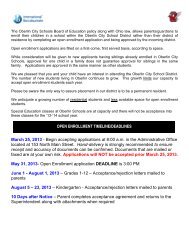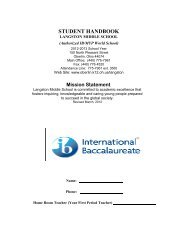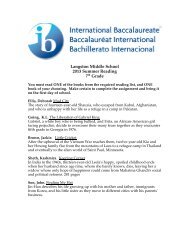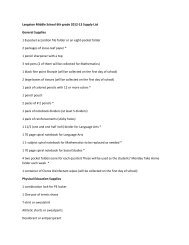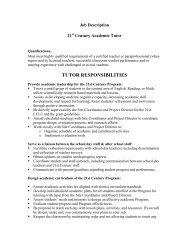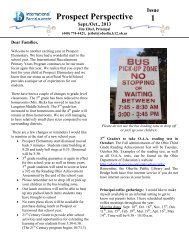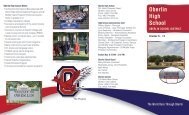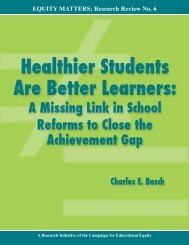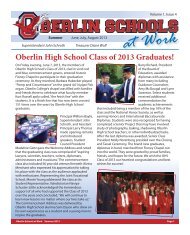Handwashing Lesson Plans Grades 7-12 - Oberlin City Schools
Handwashing Lesson Plans Grades 7-12 - Oberlin City Schools
Handwashing Lesson Plans Grades 7-12 - Oberlin City Schools
Create successful ePaper yourself
Turn your PDF publications into a flip-book with our unique Google optimized e-Paper software.
Covering Coughs & Sneezes: Hand Washing <strong>Lesson</strong> <strong>Plans</strong><br />
<strong>Grades</strong> 7-<strong>12</strong> (can be adapted for younger and older groups)<br />
Activities<br />
“Mister” Sneeze<br />
1) Fill a spray bottle with water (use colored water for special effect) and set the nozzle to<br />
“mist”.<br />
2) Explain to class that the water is like all the germs inside of each of them.<br />
3) Pretend to sneeze (don’t cover up sneeze), and as you do spray the water on the<br />
children sitting in front of you. Walk around the room and continue to pretend sneeze and<br />
cough while spraying water.<br />
4) Explain that this activity demonstrates how germs are spread when you don’t cover<br />
your cough or sneeze.<br />
5) Now, use a tissue to cover up a pretend sneeze/cough. Repeat, using your elbow or<br />
upper arm to cover the sneeze/cough.<br />
6) Explain that this activity demonstrates how germs are prevented from spreading by<br />
using the tissue or your elbow.<br />
From: Hummingbird Educational Resources,<br />
http://www.hummingbirded.com/personal‐hygiene.html<br />
Germy Puffs<br />
1) Explain that the class will be demonstrating what happens if they don’t cover their<br />
coughs/sneezes.<br />
2) Sprinkle small amount of baby powder on palm, then pretend to sneeze/cough while<br />
blowing the baby powder off your palm.<br />
3) Ask students: What happened to the powder? How are germs like the powder?<br />
4) Repeat step 2, but cover cough/sneeze with a tissue and then your elbow.<br />
5) Ask students: What happened to the powder now? Did this slow the spread of germs?<br />
Adapted from Science Surprises! Ready‐to‐Use Experiments & Activities for Young<br />
Learners by Jean R. Feldman, Ph.D<br />
©2000‐2007 Pearson Education, Inc. All Rights Reserved.<br />
Agar Dishes<br />
1. Have students identify areas in the classroom (or school) where they think the most<br />
germs are found. (Water fountain handles have been shown to have the most germs of<br />
any surface in a school‐ recommend this location to your students.)<br />
2. Using a cotton swab, have students swab these areas and then run the swab across an<br />
agar dish.<br />
3. Label each agar dish with the location of the swab.<br />
4. Leave agar dishes in a warm location for a few days. Observe the growth on each plate
5. Have students answer questions such as:<br />
• What kinds of organisms grew in the agar dishes (bacteria, viruses, fungi, fecal<br />
matter)?<br />
• How did they get on the surface? (Have students describe the journey of the<br />
germ from the surface to its origin. Ex: Virus on Billy’s pencil came from Billy’s<br />
hand, which came from Jane’s pen, which came from Jane’s hand, which came<br />
from Bob’s hand, which came from Bob’s sneeze that he covered up with his<br />
hand.<br />
• How long can the germ live on the surface? (many viruses can live for days on<br />
surfaces)<br />
• How can you prevent germs from spreading? (covering coughs and sneezes<br />
correctly, hand washing, staying home when sick)<br />
Ways to Integrate Disease Spread Into Curriculum<br />
Math<br />
Create story problems using the replication of bacteria and viruses<br />
Example: Billy doesn’t cover his sneeze and respiratory droplets from his sneeze land on<br />
his desk. The<br />
droplets contain 200 viruses. The viruses divide to form two new viruses every minute.<br />
How many<br />
viruses would be on Billy’s desk after 10 minutes?<br />
Language Arts<br />
Write a poem about how to stay healthy from colds and flu<br />
Example:<br />
Rhyming‐ I hate when my germs find you,<br />
So I cover up with a tissue.<br />
Every time I sneeze,<br />
I put my nose to my sleeve.<br />
Haiku‐ I spread lots of germs<br />
if I don’t use a tissue<br />
when I say achoo.<br />
Write a research paper on contagious diseases and the recommendations on disease<br />
prevention.<br />
Science<br />
Swab classroom surfaces and grow cultures on petri dishes when studying microbes.<br />
Implement cover the cough techniques, hand sanitizer, hand washing, and routine<br />
cleaning to see how it effects the growth.
Social Studies/History<br />
When studying other cultures, talk about different ways of greeting and how these<br />
differences can inhibit or welcome the spread of disease. When reviewing historical<br />
periods, discuss how disease ran rampant b/c of lack of knowledge of disease<br />
prevention.<br />
Art<br />
Use photos from electron microscopes to explore the beauty of viruses and bacteria.<br />
Make a collage of images of bacteria, viruses, pollen and fungi. Explain to students that<br />
the images are beautiful but the resulting diseases are not.<br />
Websites (on preventing the spread of disease)<br />
http://www.bam.gov/ http://www.toronto.ca/health/sleeve_sneeze.htm<br />
http://www.teenhealth.org/teen/ www.itsasnap.org



